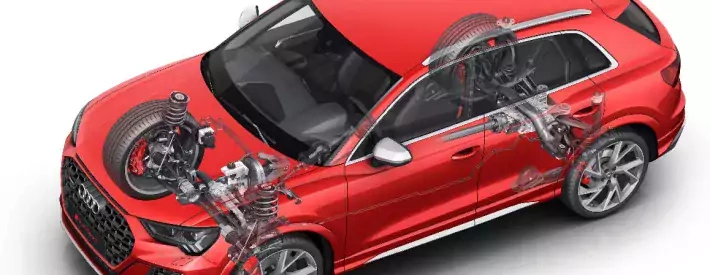Back to basics: Suspension and steering - Part Two

In this article: In part two of the series, take an in-depth look at how areas including centre of gravity and centre of pressure impact on a vehicles ride and handling
A vehicles ride and handling is defined by the basic setup of its suspension – toe, caster and camber – but there are other elements that have a huge impact too. In the second part in the series, we take a closer look at how centre of gravity, centre of pressure, roll centre and roll control impact on the vehicle.
Centre of Gravity (CoG)
The centre of gravity lies on the vehicle centre line, and is the balance point of the moments from the front axle weight and the rear axle weight relative to the ground contact points, or wheelbase.
Naturally the CoG moves depending on how the vehicle is loaded, but for passenger cars the payload relative to the kerb weight is usually relatively small, but the mass distribution above ground level is critical; the higher the CoG is above the ground the more readily the vehicle will lean during cornering.
For passenger cars most of the mass is concentrated as close to the bottom of the body as possible, but for trucks, buses and coaches the lowest part of the load bearing structure may well be more than 1m above the ground level.
Centre of Pressure (CoP)
Every vehicle has a centre of pressure which occurs along the centre line of the vehicle, assuming it is symmetrical. All vehicles develop aerodynamic forces as the vehicle speed increases, and the objective is to reduce the natural upward force, (lift), with air management which may result in a downward force, (downforce).
Typically to reduce lift, engineers minimise the volume of air passing underneath the body and maximise attachment of air to the upper surfaces. The aerodynamic force on each end of the vehicle will have a balance point, where the force multiplied by the distance from the centre of pressure (the moment) is equal.
For the best stability in a straight line the CoG needs to be biased towards the front of the vehicle. For zero side wind effects the CoP should be as close to the CoG as possible – the bigger the distance between the CoP and the CoG, the bigger the moment and the more nervous the vehicle will be in side wind conditions. If the CoP is behind the CoG, the vehicle will turn into the cross wind, which is counter intuitive for the driver.
Roll centre
If we draw lines from the attachment points of the suspension to the body they will converge at a point some way outside the vehicle. The line from that convergence point to the centre of the tyre contact patch will cross the vehicle centre line, and that is where the roll centre occurs.
For vehicles with dead or live axles, the roll centre will pass through the outer spring during cornering. But for independent suspension the roll centre may well move depending on the suspension deflection, although it will always occur on the vehicle centre line. On a vehicle with independent suspension on one axle angle only the roll centre is much more dynamic than for a vehicle with fully independent suspension.
The roll axis is the line joining the front and rear roll centres, and the height of the CoG as well as the CoP above or below this axis will determine how much the vehicle will roll. The ultimate goal is the roll axis will not have a steep inclination, will not move vertically as the suspension is displaced and passes as close as possible to the CoG as well as the CoP.
Roll control
This is usually achieved by adding a spring that acts between the opposite sides of the vehicle, to counter the moment caused by the CoG position relative to the roll axis. These are called anti-roll bars, and have one rate – the torsional stiffness of the bar along with the length of the links attaching it to the suspension. For off-road conditions where a vehicle will typically travel at much lower speeds but be much more reliant on axle articulation, there is a device that allows the anti-roll bar to be decoupled.
Another technique is to use adaptive damping to increase the resistance to roll. In some cases if the vehicle has air suspension, to increase the outer air spring pressure to counter roll. In all cases the system needs sensor data to distinguish between hitting a road obstacle, where we need suspension compliance, and the longer duration cornering events, and systems can take information including engine speed, vehicle speed, suspension movement and acceleration.
The latter items are achieved using Hall effect sensors usually attached to one link per side of the suspension, and an accelerometer usually mounted on the damper body. These are both features of adaptive damping systems.




